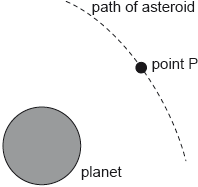| Date | November 2019 | Marks available | 1 | Reference code | 19N.2.HL.TZ0.8 |
| Level | Higher level | Paper | Paper 2 | Time zone | 0 - no time zone |
| Command term | Show that | Question number | 8 | Adapted from | N/A |
Question
In a classical model of the singly-ionized helium atom, a single electron orbits the nucleus in a circular orbit of radius r.
The Bohr model for hydrogen can be applied to the singly-ionized helium atom. In this model the radius , in m, of the orbit of the electron is given by where is a positive integer.
Show that the speed of the electron with mass , is given by .
Hence, deduce that the total energy of the electron is given by .
In this model the electron loses energy by emitting electromagnetic waves. Describe the predicted effect of this emission on the orbital radius of the electron.
Show that the de Broglie wavelength of the electron in the state is m.
The formula for the de Broglie wavelength of a particle is .
Estimate for , the ratio .
State your answer to one significant figure.
The description of the electron is different in the Schrodinger theory than in the Bohr model. Compare and contrast the description of the electron according to the Bohr model and to the Schrodinger theory.
Markscheme
equating centripetal to electrical force to get result ✔
uses (a)(i) to state OR states ✔
adds « » to get the result ✔
the total energy decreases
OR
by reference to ✔
the radius must also decrease ✔
NOTE: Award [0] for an answer concluding that radius increases
with ✔
OR ✔
✔
NOTE: Allow ECF from (b)(i)
reference to fixed orbits/specific radii OR quantized angular momentum in Bohr model ✔
electron described by a wavefunction/as a wave in Schrödinger model OR as particle in Bohr model ✔
reference to «same» energy levels in both models ✔
reference to «relationship between wavefunction and» probability «of finding an electron in a point» in Schrödinger model ✔


